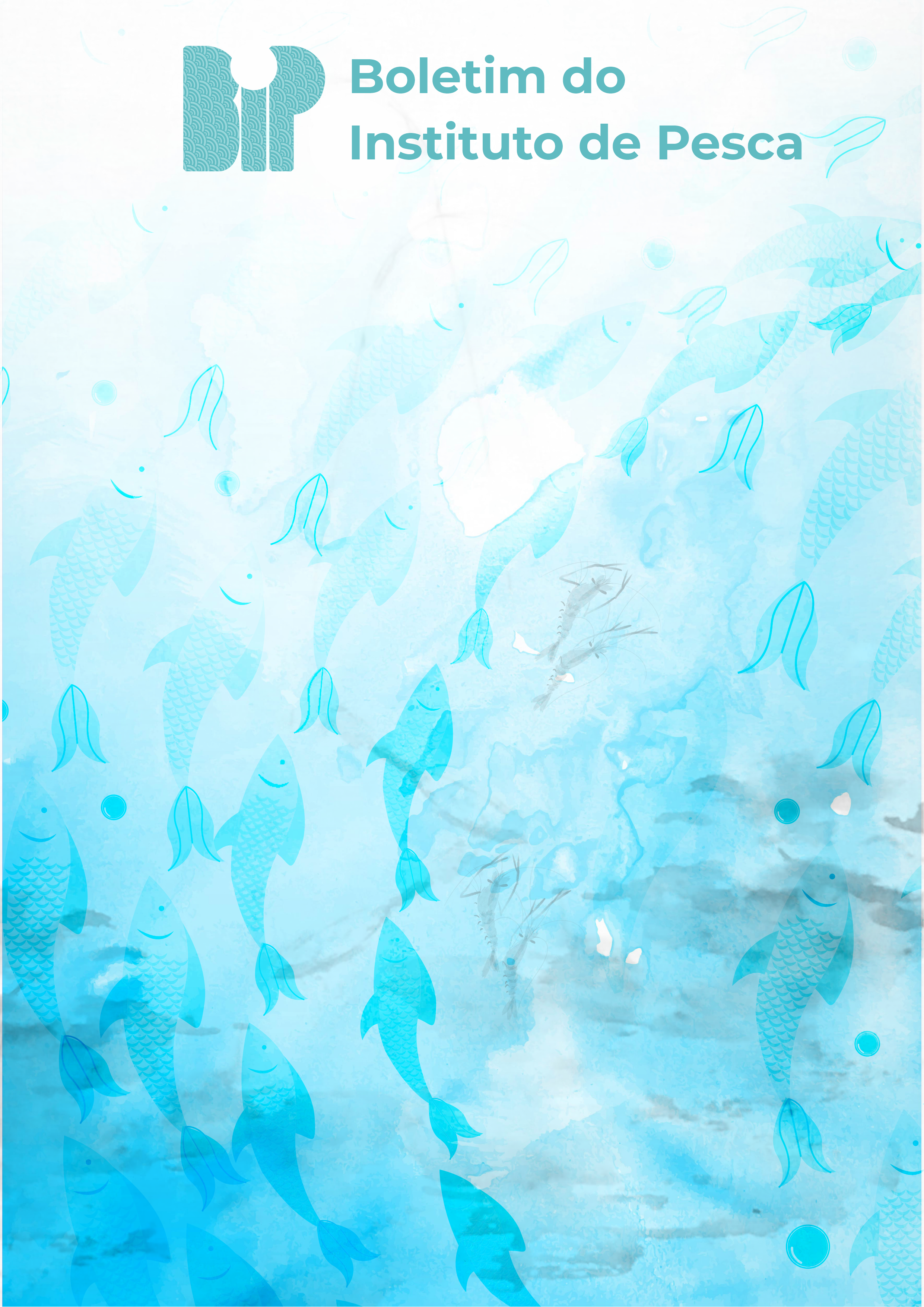Use of nylon net packing to increase the survival time of cultured mussels
Keywords:
Bivalve molluscs, Shelf life, Perna pernaAbstract
Mussels survive a few days after harvesting, limiting the trade of these animals when alive. The study evaluated the effect of nylon net packing on the survival and shelf life of Perna perna mussels farmed in Brazil. Thirty samples containing 10 or 11 market-size mussels were stored in an incubator at 4°C for four days, half packed with nylon netting and the other half maintained within opened containers. The experiment analyzed the following parameters daily: survivorship, intervalvar fluid loss, total volatile bases, pH, and mesophilic and psychrotrophic bacteria counts. By the end of the assay, chemical and microbiological parameters were all acceptable for human consumption. All packed mussels survived up to the second day of storage, while the control group recorded an average survival of 29.7% in the same period. Packed mussels survive longer, probably because the tight net prevents animals from losing liquid by maintaining their shell valves closed during storage. This packaging method extends the shelf life of live products and improves the potential trading live mussels to consumer centers far from marine farms.
References
American Public Health Association (APHA). 2015. Compendium of methods for the microbiological examination of foods. 5.ed. United States: APHA.
Ashie, I.N.A.; Smith, J.P.; Simpson, B.K.; Haard, N.F. 1996. Spoilage and shelf-life extension of fresh fish and shellfish. Critical Reviews in Food Science and Nutrition, 36(1-2): 87-121. https://doi.org/10.1080/10408399609527720
Associação Brasileira de Normas Técnicas (ABNT). 2015. ISO 4833: Microbiologia da cadeia produtiva de alimentos - Método horizontal para a enumeração de microrganismo. Parte 1: Contagem de colônias a 30°C pela técnica de pour plate. Available at: https://www.normas.com.br/visualizar/abnt-nbr-nm/35147/nbriso4833-2-microbiologia-da-cadeia-produtiva-de-alimentos-metodo-horizontal-para-
a-enumeracao-de-microrganismos-parte-2-contagem-de-colonias-a-30-c-pela-tecnica-de-plaqueamento-em-superficie. Accessed on: Mar. 1, 2023.
Barni, E.J.; Silva, M.C.; Rosa, R.C.C.; Ogliari, R.A. 2003. Perfil, hábitos de consumo e preferências dos consumidores finais de mexilhões. Agropecuária Catarinense, 16(3): 39-43.
Barrento, S.; Lupatsch, I.; Keay, I.; Shields, S. 2013. Protocol on best practice handling and transportation of live mussels. Technical Report supported by Project no. 243452, FP7-SME Mussels Alive, 59 p.
Brasil. 2019. Manual de Métodos Oficiais para Análise de Alimentos de Origem Animal. 2nd ed. Brasília: Ministério da Agricultura, Pecuária e Abastecimento, Secretaria de Defesa Agropecuária, 158 p.
Brasil. 2022. Agência Nacional de Vigilância Sanitária. Instrução Normativa no. 161, de 1o de julho de 2022. Estabelece os padrões microbiológicos dos alimentos. Diário Oficial da União, Seção 1(126): 235.
Demarchi, C.G. 2003. Estudo de mercado: o comércio de ostras e mexilhões em Santa Catarina. Internal report. Florianópolis: Universidade Federal de Santa Catarina, 68 f. Available at: https://repositorio.ufsc.br/bitstream/handle/123456789/117842/194094.pdf?sequence=1.Accessed on: Mar. 1, 2023.
Dunphy, B.J.; Watts, E.; Ragg, N.L. 2015. Identifying thermally-stressed adult greenlipped mussels (Perna canaliculus Gmelin, 1791) via metabolomic profiling. American Malacological Bulletin, 33(1): 127-135. https://doi.org/10.4003/006.033.0110
Food and Agriculture Organization (FAO). 2022a. Global aquaculture production. Rome: FAO. Available at: https://www.fao.org/fishery/statistics-query/en/aquaculture.Accessed on: Mar. 1, 2023.
Food and Agriculture Organization (FAO). 2022b. GLOBEFISH Highlights: International markets for fisheries and aquaculture products. 2nd ed. Rome: FAO. https://doi.org/10.4060/cc1350en
Furlan, E.F.; Galvão, J.A.; Salán, E.O.; Yokoyama, V.A.; Oetterer, M. 2007. Estabilidade físico-química e mercado do mexilhão (Perna perna) cultivado em Ubatuba – SP. Ciência e Tecnologia de Alimentos, 27(3): 516-523. https://doi.org/10.1590/S0101-20612007000300015
Hirabayasi, M.; Okazaki, T.; Tanimoto, S. 2022. Changes in extractive components in live Mytilus galloprovincialis mussels during ice storage. Food Science and Technology, 88: 181-189. https://doi.org/10.1007/s12562-021-01568-9
International Commission on Microbiological Specifications for Foods (ICMFS). 1986. Sampling for microbiological analysis: principles and specific applications. 2nd ed. London: Blackwell Scientific Publications, 131 p.
Monfort, M.C. 2014. The European market for mussels. Globefish, v. 115. Rome: FAO, 65 p.
Nicastro, K.R.; Zardi, G.I.; McQuaid, C.D.; Pearson, G.A.; Serrão, E.A. 2012. Love thy neighbour: group properties of gaping behaviour in mussel aggregations. PLoS One, 7(10): e47382. https://doi.org/10.1371/journal.pone.0047382
Observatório Agro Catarinense (2023). Produção agropecuária: Aquicultura. Observatório Agro
Catarinense. Available at: https://www.observatorioagro.sc.gov.br/areas-tematicas/producao-agropecuaria/paineis/. Accessed on: Mar. 2, 2023.
Ogawa, M.; Maia, E.L. 1999. Manual da pesca: ciência e tecnologia do pescado. São Paulo: Varela, v. 1, 430 p.
Silvestri, F.; Cordeiro, G.B.; Costa, P.M.S. 2018. Parâmetros reprodutivos do mexilhão Perna perna (L. 1758) em fazendas marinhas na Ilha Grande (RJ). ActaFish, 6(1): 43-49. https://doi.org/10.2312/Actafish.2018.6.1.43-49
Weldon, J.W. 1999. Abiotic and biotic factors affecting the survival and shelf life of the blue mussel, Mytilus edulis (Linnaeus, 1758) [dissertation]. Saint John: University of New Brunswick, 139 p. Available at: https://library-archives.canada.ca/eng/services/services-libraries/theses/Pages/item.aspx idNumber=52193552. Accessed on: Mar. 1, 2023.
Wucher, H.; Klingshirn, A.; Brugger, L.; Stamminger, R.; Geppert, J.; Kölzer, B.; Engstler, A.; Härlen, J. 2020.Tackling food waste: Impact of German consumer behaviour on food in chilled storage. Foods, 9(10): 1462. https://doi.org/10.3390/foods9101462
Yap, W.G.; Orano, C.F. 1980. Preliminary studies on the holding of live mussels after harvest. SEAFDEC Aquaculture Department Quarterly Research Report, 4(3): 22-24.
Downloads
Published
Issue
Section
License
Copyright (c) 2023 Felipe Matarazzo Suplicy, Fabiele Bernardi, Robson Ventura de Souza, Marília Miotto, Giustino Tribuzi

This work is licensed under a Creative Commons Attribution 4.0 International License.










